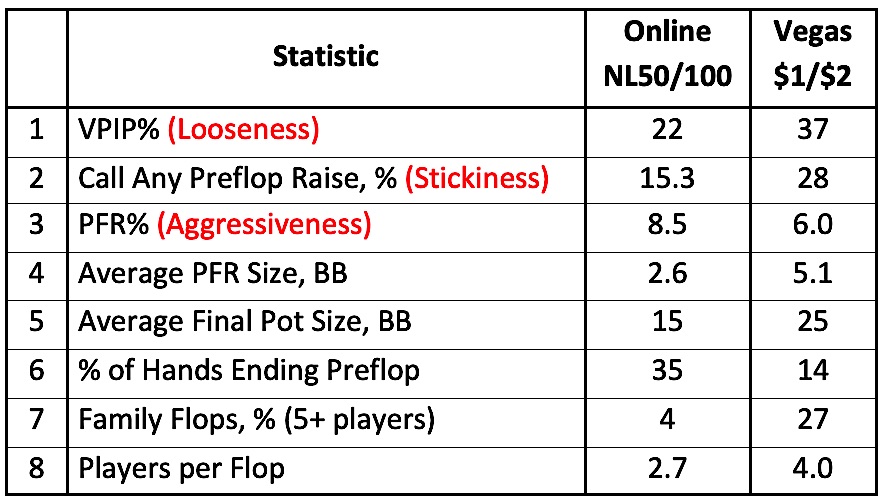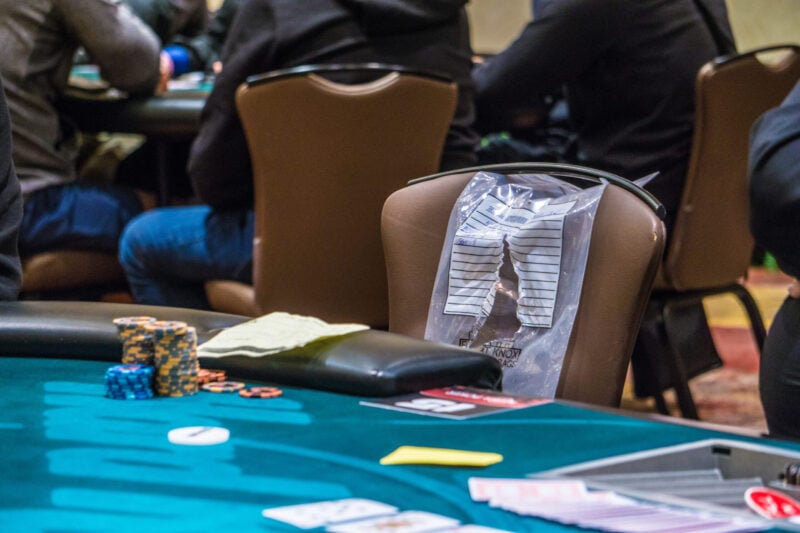It is relatively easy to find playing stats for online poker. We can monitor our own stats by using software such as PokerTracker or Hold’em Manager. We can even purchase hand histories and import them into our database program, as I did for my book The Statistics of Poker.

Figure 1 lists eight key online stats for NL50 and NL100 games, which were derived from 6 million hand histories for NL50 and NL100.
“It’s immoral to let a sucker keep his money.” Canada Bill Jones
It’s not nearly so easy to obtain stats for live poker. But while researching my Donkey Poker books, I recorded nearly 1,000 full-ring hand histories at four Las Vegas card rooms at various times of the day and on different days of the week over a three-month period. This allowed for a statistically valid comparison of how the game is played online with how it’s played at the low-stakes tables in Las Vegas. (Strip card rooms seem to be slightly looser than off-Strip card rooms.)
Merging data from all of these hands provides a reasonable estimate of how a typical Vegas $1/$2 game plays, to something near a ±5% reliability. (Full details of my methodology can be found in Chapter 7.5 of Donkey Poker, Vol. 2: Postflop.)
Live Vegas NLH Dynamics
The data shows us that Vegas players are much looser, much stickier, and less aggressive than online players. Furthermore, average preflop raises and winning pot sizes are much larger in live play. Vegas hands are much more likely to see a flop more, and those flops generally contain more involved players.
These features combine to make the typical Vegas game much different from an average online game — so optimal Vegas live play will be different, too. This is a key reason some good online players find it frustrating to play live no-limit hold’em. “I can’t beat these donkeys; they won’t fold when they’re supposed to,” is a common lament.
The solution is to adapt to the dynamics of the live Vegas game.
Vegas Players Are Far Too Loose
In the chart above, VPIP% stands for “Voluntarily Put money In the Pot”, which is just a measure of looseness. The higher our VPIP%, the looser we play. (This stat includes only hands we voluntarily fund, and doesn’t include hands where we post a blind but don’t put additional money in the pot.)
We can see that Vegas players are about 70% looser than online players, which is a key reason Vegas games are so easy to beat. When our opponents play too many hands, they must fold too many hands on the flop when they miss. Or perhaps they lose even more when they play an extra street or two with “marginal” hits. Such play is especially problematic in Vegas live games because most flops are multi-way, making it more difficult to win without the best hand.
Great players may be able to eke out a profit in some of these marginal situations with great postflop play. But the rest of us should simply avoid the temptation. Playing too loose preflop is akin to building our poker pyramid on top of sand.
Vegas Players Are Far Too Sticky
Vegas players raise at a much lower rate than online players (6.0% vs. 8.5%). Since they have a much tighter preflop raising range, our calling range should also be tighter. (The Cap Concept states that we should call a raise with a range tighter than that of the raiser.) Furthermore, the average Vegas raise is nearly twice as large (5.1 BBs vs. 2.6 BBs), arguing for an even tighter calling range.
Yet, just the opposite occurs in Vegas $1/$2 games: Vegas players call preflop raises at nearly twice the rate of online players (28% vs 15%). This is a worse leak than playing too many hands since these hands are played at a high cost. Again, we will miss most flops and must often fold, especially in multi-way pots.
Most of us will just lose more money by chasing in these situations. Our most common action when facing a preflop raise should be to fold or to 3-bet. We should rarely flat call, especially with dominated combos like KJo and ATs.
Trouble in the Family Pots
A Vegas $1/$2 hand is much less likely to end preflop (14% vs. 35%). Lots of flops are unraised and Vegas players just don’t like to fold when they are raised.
Additionally, the average Vegas flop contains more players (4.0 vs. 2.7).
Consider a common online scenario: Hero opens from the cutoff to 2.5 BBs and gets a call from the big blind. Hero misses the flop, the big blind checks and Hero makes a continuation bet of 2.5 BBs. The Villain folds and Hero wins the pot. Online players typically make relatively small investments with relatively low postflop risks.
But this scenario is rare in a live small-stakes game. More commonly, there are two limpers before Hero raises in the cutoff to 6 BBs, getting three callers. After missing the flop, and with something near 24 BBs in the pot, Hero declines to c-bet into the three villains. Or perhaps he decides to c-bet half-pot and gets one caller, losing even more money by the end of the hand.
Vegas players typically make relatively large preflop investments with a relatively large postflop risk.
This dynamic is why many low-stakes Vegas players decline to raise their marginal hands — they have instinctively found that it doesn’t pay off. And it’s why Vegas raises are much larger than online raises, as a 2.5 BB raise simply doesn’t fold out anyone who likes their hand.
It makes sense that the average Vegas preflop raise percentage is low. It’s simply not profitable to raise as widely as we can online. The live Vegas game is less aggressive for a good reason.
Hopeful Strategy?
Vegas players clearly want to play as many pots as possible — they limp a lot and call a lot of raises. If they like their cards, they play them. For them, hope springs eternal.
Many live players play for only two or three hours after spending additional time traveling and on the waiting list. Once in their seat, they don’t feel inclined to wait for strong starting cards. They are often driven by impatience and hope.
Online players have it easier in some ways. They can begin playing immediately without traveling to a casino. They are dealt more hands per hour and can play multiple tables simultaneously. Thus, it’s much easier for them to remain patient.
Conclusion
There are many factors to consider for beating small-stakes Vegas NLH. Vegas players are very loose and very sticky. We need to adapt by playing more selectively, which means playing fewer hands, especially to a raise and especially when we will have poor postflop position.
Steve Selbrede is the author of six poker strategy books: The Statistics of Poker, Beat the Donks, Donkey Poker Volume 1: Preflop, Donkey Poker Volume 2: Postflop, Donkey Poker Volume 3: Hand Reading and Tournament Poker for the Rest of Us.


